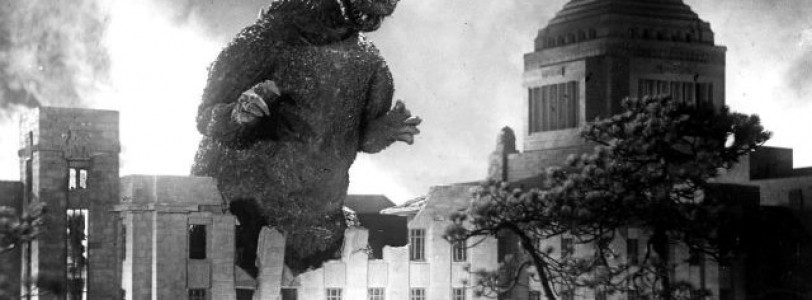Everyone is familiar with the monster Godzilla and the nuclear bombings of Japan in 1945. However, these two things share a very toxic similarity. A similarity that devastated cities and took the lives of hundreds of thousands of civilians. However, how can one watch Godzilla, directed by Ishiro Honda in 1954, feel the haunting reminder of Japan’s nuclear bombings? It comes down to our antagonist Godzilla itself.
The films narrative tells the story of Japan’s experience of a nuclear holocaust. Godzilla acts as a metaphor for the catalyst of this holocaust. The audience is shown scenes of Godzilla tearing down buildings, leaving nothing but ruins. Ruins like that of the aftermath of the bombs. Buildings that once stood tall, now lay in rubble. The city becomes a graveyard of what it used to be. When Godzilla disappears back into the ocean, the people are left to the deal with the aftermath of the attack. They are left to rebuild their lives and their city. After the 1945 bombings, Japan was left to rebuild their lives amongst the civilian casualties and radiation poisoning. Similarly to the film, the bomb left Nagasaki and Hiroshima in rubble.
The most notable scene in Godzilla that nods towards the bombings of Nagasaki and Hiroshima is towards the end of the film. Dr Serizawa watches a TV broadcast displaying a city in ruins, hospitals overflowing with many injured. The images of the injured citizens in the film look no different to those in real life. The realism of these images contribute to Honda’s anti-nuclear message in the narrative of Godzilla. This is one of the key scenes in the film that was so reminiscent of the aftermath of the nuclear attack. It is a scene that sits with the audience. Upon the initial release of Godzilla, Japanese audiences watched in silence, occasionally breaking the silence with sobs. Godzilla was released only 9 years after the bombings. Survivors of this would definitely watch this film with their experiences in mind and seeing this scene of the overcrowded hospital is something that once was reality for them. Godzilla is more than a b-movie about a giant monster, it a metaphor that reflects a very real event. The message Honda has is still relevant today, especially now since nuclear weapons are now much more powerful than they once were.







That's a great comparison Lauren, and not something I had thought about! It makes you see the film in a completely different light! Do you think Honda would be shocked to discover that Godzilla has been turned into such a mainstream cash-cow (multiple films — including crossover films — books, videogames, etc.) and that his original message has been lost?